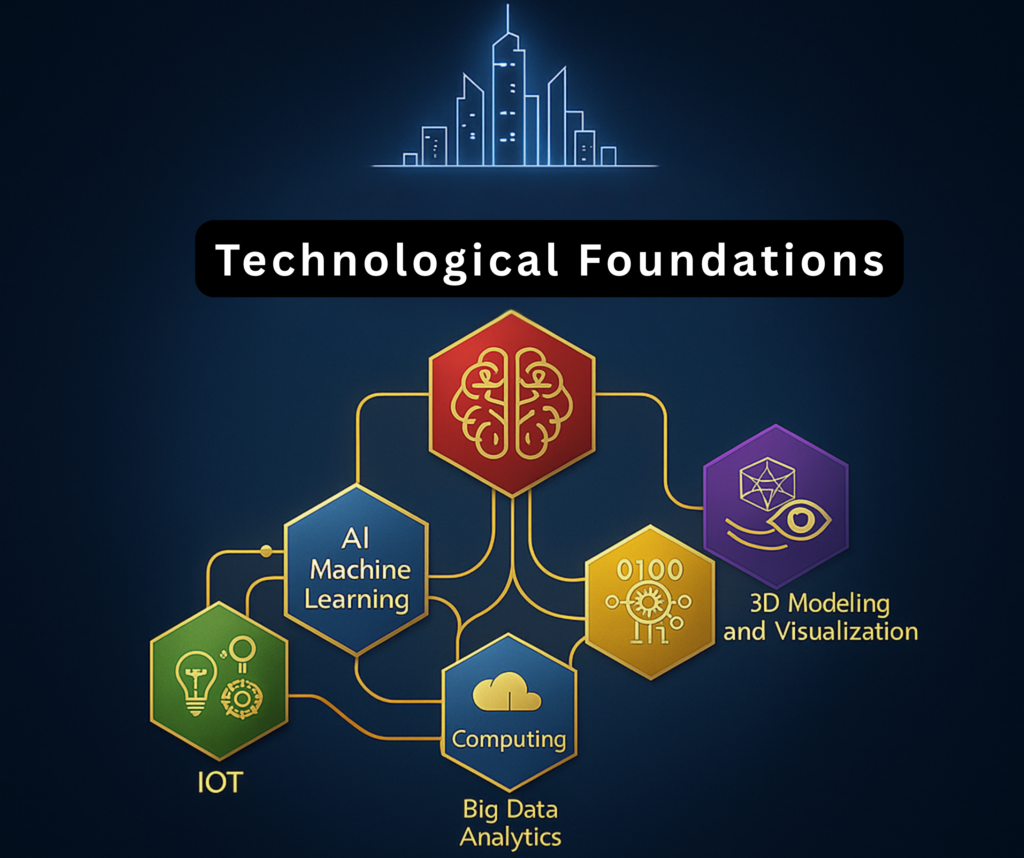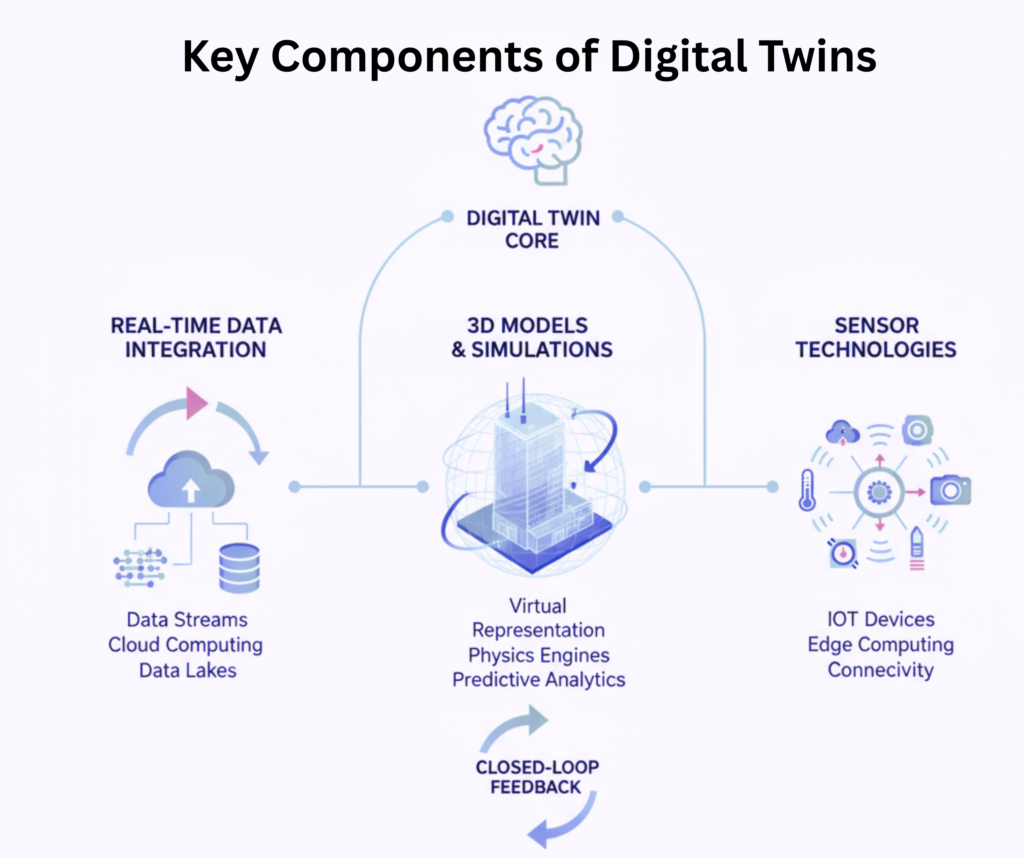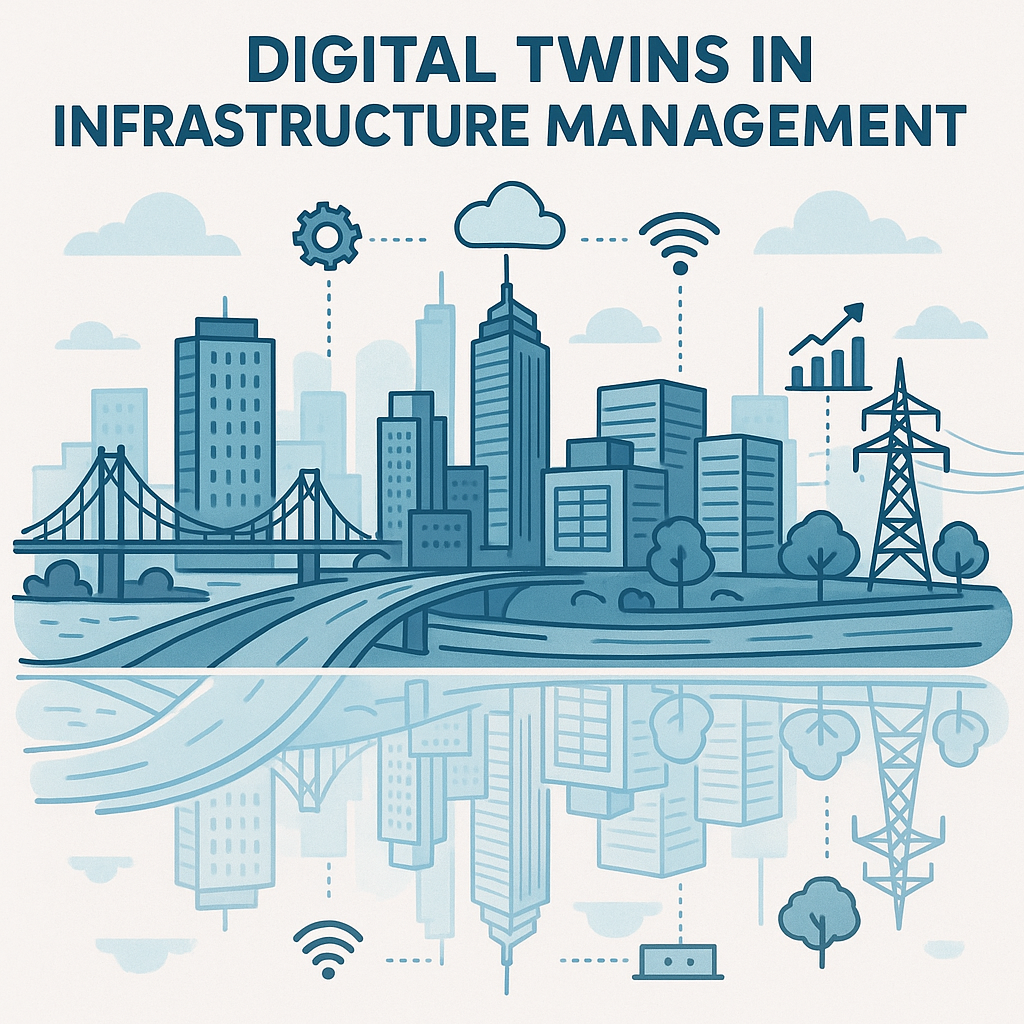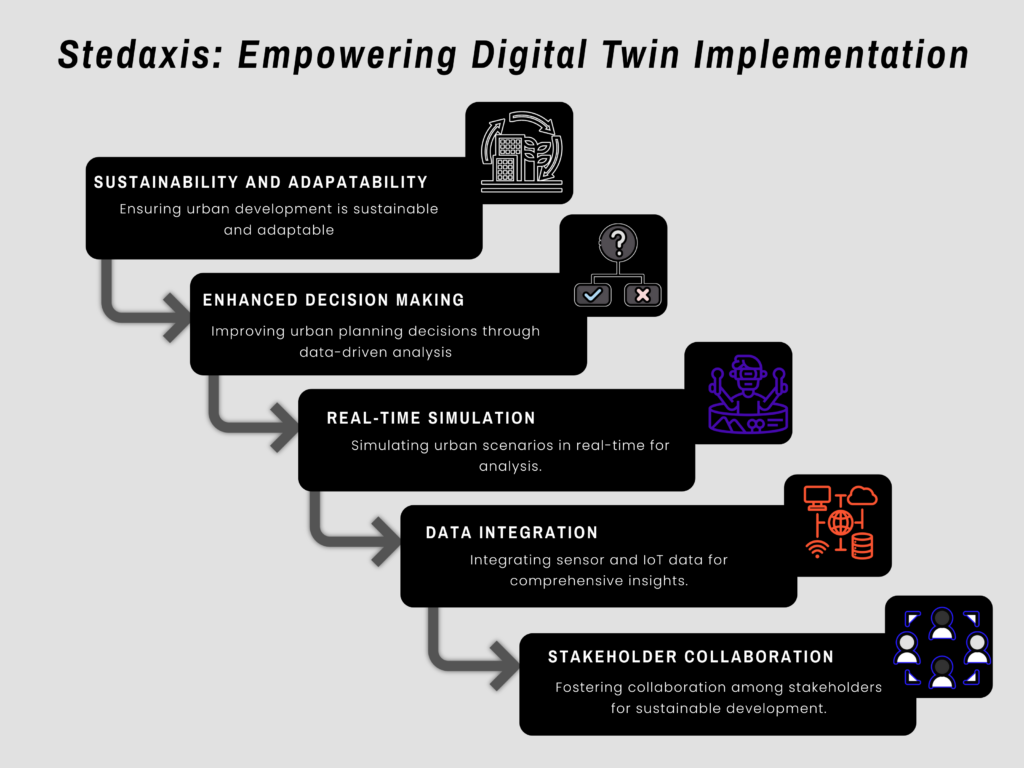The concept of Digital Twins is rapidly emerging as a transformative force in urban planning and smart city development. A digital twin is a virtual replica of a physical object, system, or process. It uses real-time data and simulations to mirror the characteristics and behaviors of its real-world counterpart. Initially introduced in the manufacturing sector, digital twins have found applications in various industries, including urban planning. By leveraging sensors, Internet of Things (IoT) devices, and big data, digital twins enable cities to simulate, monitor, and analyze complex urban environments in real time.
Importance of Digital Twins in Urban Planning
Urban planning has always faced challenges due to the complex nature of cities. From population growth and resource management to environmental concerns, planners often struggle to keep pace with the changing dynamics of urban life. Traditional urban planning methods involve a lot of manual work, paper-based processes, and non-integrated data sources. This often results in inefficient systems, misinformed decisions, and increased operational costs.
How Digital Twins Work in Smart Cities
In smart cities, digital twins have emerged as a crucial tool in transforming urban infrastructure. These virtual models act as digital replicas of cities, neighborhoods, or individual structures, integrating various layers of real-time data to simulate how a city functions. Smart sensors, embedded within buildings, streets, and public utilities, feed this data into digital twin systems, enabling cities to monitor and analyze their environments with unprecedented precision.
A digital twin is essentially a virtual model that reflects the physical assets, systems, and processes of the real world. In urban planning, this model represents everything from traffic systems to public services, green spaces, and even residential areas. By incorporating various data streams from sensors and devices within the physical city, digital twins allow for dynamic simulations that mirror real-world interactions, behaviors, and conditions.

Technological Foundations
The success of digital twins is deeply rooted in advancements in several key technologies:
- IoT (Internet of Things) – This network of connected devices and sensors allows for continuous data collection and real-time monitoring of urban environments.
- Cloud Computing – Data processing and storage are increasingly being handled in the cloud, enabling better scalability and accessibility of digital twin systems.
- Big Data Analytics – The ability to analyze vast amounts of data from sensors and devices allows for deeper insights and predictive modeling.
- AI and Machine Learning – These technologies enable advanced simulations, real-time decision-making, and intelligent predictions.
- 3D Modeling and Visualization – Detailed digital models of cities or infrastructure help visualize complex systems and make it easier to communicate insights to stakeholders.
Historical Context of Urban Planning
Urban planning has always been a multifaceted challenge, balancing growth, sustainability, and the well-being of citizens. In the early stages, cities were planned with basic infrastructure such as roads and buildings. However, as urbanization intensified and technological advances made more complex systems feasible, traditional planning approaches struggled to address challenges like traffic congestion, resource distribution, and environmental sustainability.
Challenges Faced in Traditional Urban Planning Methods
Traditional urban planning has faced numerous challenges:
- Fragmented data – Data from different sources often lacks integration, making comprehensive planning difficult.
- Slow decision-making – In large cities, decisions often take months or even years to implement, delaying urgent interventions.
- Resource management issues – Cities often face inefficiencies in energy use, waste management, and water distribution.
- Environmental concerns – Climate change and urban sprawl demand innovative solutions for sustainability.
Digital Twins as a Game-Changer
Digital twins act as a solution to these issues by enabling planners to simulate scenarios, monitor real-time conditions, and predict outcomes before making decisions. As a digital representation of the real world, a digital twin gives urban planners a dynamic model to work with, providing tools for predictive analysis and the ability to optimize decisions on the fly. It brings automation and integration to city management in a way that was never before possible.

Key Components of Digital Twins
Real-Time Data Integration
Real-time data is the foundation of digital twins. By integrating data from sensors and connected devices throughout the city, urban planners can gather insights on various factors, such as traffic flow, energy consumption, air quality, and weather conditions. This data allows for instant updates and simulations, giving planners the ability to monitor changes as they happen and adjust strategies accordingly.
3D Models and Simulations
Digital twins rely heavily on 3D modeling and simulation technologies to create accurate representations of urban environments. These models allow for detailed visualizations of city structures and infrastructure, helping planners and stakeholders understand potential impacts of different planning decisions. Whether it’s simulating traffic flow, energy distribution, or environmental factors, 3D models are indispensable tools in urban planning.
Sensor Technologies
Sensors embedded in buildings, streets, and utilities continuously feed data into digital twin systems. These sensors are critical in capturing real-time information about the environment. For example, smart streetlights can monitor traffic and adjust their brightness based on traffic density. Similarly, smart grids can help optimize electricity use, reducing energy waste.
How Digital Twins Enhance Smart Cities
Improved Resource Management (Energy, Water, Waste)
One of the primary benefits of digital twins in urban planning is their ability to enhance resource management. By using real-time data from sensors, digital twins allow cities to optimize the distribution of energy, water, and waste management systems. For instance, cities can use digital twins to monitor water usage and detect leaks in the system, improving efficiency and reducing waste.
Real-Time Monitoring and Decision-Making
Real-time monitoring enables cities to detect problems and inefficiencies quickly. When combined with advanced analytics, this data allows decision-makers to take immediate action. For example, if a traffic jam occurs in one area, planners can reroute traffic or adjust signal timings to alleviate congestion.
Traffic Management and Optimization
In a smart city, traffic management is crucial. Digital twins allow cities to simulate traffic patterns and optimize routes based on real-time data. This technology can help in reducing congestion, lowering travel time, and improving public transport systems.

Digital Twins in Infrastructure Management
Digital twins also play a critical role in infrastructure management. By simulating the condition of roads, buildings, and bridges, cities can predict when repairs are needed or when infrastructure upgrades are due. This proactive approach reduces costs and ensures public safety by addressing issues before they become critical.
Sustainability and Environmental Impact
Digital twins enable urban planners to create more sustainable cities by simulating the environmental impact of various planning decisions. From assessing the effectiveness of green roofs to evaluating the benefits of energy-efficient buildings, digital twins can significantly help in reducing a city’s carbon footprint.
Benefits of Digital Twins in Urban Planning
Faster and More Accurate Decision-Making
Digital twins offer real-time insights and predictive capabilities, enabling cities to make decisions much faster and with greater accuracy. This allows urban planners to respond to unforeseen events, like traffic incidents or power outages, more quickly.
Enhanced Collaboration Among Stakeholders
Urban planning is a collaborative effort. Digital twins bring together a wide range of stakeholders—such as city planners, government officials, architects, and the public—by providing a common platform where they can visualize plans and offer input.
Real-Time Predictions and Simulations
Digital twins allow urban planners to simulate multiple scenarios and predict outcomes. Whether testing different traffic management strategies or assessing how a new development would affect the environment, digital twins provide insightful simulations that inform long-term planning.
The Challenges and Limitations of Implementing Digital Twins
Despite their advantages, digital twins come with challenges:
- High initial costs – Implementing a digital twin system can be expensive due to infrastructure, sensors, and data collection.
- Data privacy and security concerns – As digital twins rely on extensive data collection, there are risks associated with data privacy and cybersecurity.
- Technical complexity – Integrating different data sources and systems can be challenging, requiring skilled professionals and a unified platform.
The Future of Digital Twins in Urban Planning
Urban planning is undergoing a radical transformation, driven by advances in digital twin technology. A digital twin is a virtual replica of a physical environment—be it a city block, an entire urban area, or critical infrastructure that allows planners, developers, and policymakers to simulate, analyze, and optimize urban systems in real time.
Emerging Trends and Innovations
Looking ahead, several trends are shaping the evolution of digital twins in urban planning:
- Integration with AI and Machine Learning: AI-powered digital twins can detect patterns, predict outcomes, and optimize city operations more efficiently than manual planning.
- 5G and Edge Computing: Faster, low-latency connectivity enables real-time updates and simulations on large-scale urban environments.
- Augmented and Virtual Reality (AR/VR): AR/VR integration allows planners and citizens to experience urban changes virtually, making complex data more accessible.
- Smart Infrastructure Integration: Linking digital twins with smart grids, autonomous transport, and IoT networks creates truly intelligent urban ecosystems.
Collaboration and Stakeholder Engagement
The future of digital twins in urban planning also emphasizes collaboration. Digital twins serve as a centralized, visual platform where city officials, architects, engineers, and residents can explore urban plans together. Interactive simulations allow stakeholders to understand proposed changes, provide feedback, and make informed decisions. This participatory approach fosters transparency, trust, and better urban outcomes, bridging the gap between planners and the communities they serve.
Predictive Modeling and Scenario Planning
One of the most powerful aspects of digital twins is their ability to perform predictive modeling. Urban planners can test multiple scenarios such as population growth, climate change impacts, or new infrastructure projects without disrupting the actual city. By simulating different outcomes, cities can identify potential risks and opportunities, prioritize investments, and develop contingency plans. This forward-looking approach reduces costly errors, improves resilience, and ensures cities are prepared for future challenges.
Collaboration and Stakeholder Engagement
Digital twins create a shared platform for city planners, architects, and residents to interact with urban plans in real time, enabling better decision-making and inclusive development. This approach fosters transparency, trust, and community involvement in city planning.
Key Benefits:
- Centralized, visual platform for all stakeholders
- Interactive simulations for proposed urban changes
- Easier feedback and informed decision-making
- Enhances transparency and trust among communities
- Bridges the gap between planners and residents

Stedaxis: Empowering Digital Twin Implementation
Stedaxis offers a comprehensive suite of solutions and services to help organizations implement and leverage digital twins effectively. Their expertise spans the entire digital twin lifecycle, from initial assessment and design to implementation, integration, and ongoing support.
Key Advantages of Partnering with Stedaxis:
- Deep Domain Expertise: Stedaxis possesses a team of experienced engineers, data scientists, and software developers with deep domain expertise in various industries. This allows them to understand the specific challenges and opportunities faced by their clients and tailor digital twin solutions to meet their unique needs.
- Comprehensive Solution Portfolio: Stedaxis offers a comprehensive portfolio of digital twin solutions, including:
- Digital Twin Platform: A scalable and secure platform for building, deploying, and managing digital twins.
- Data Integration Services: Services to connect to various data sources, including sensors, IoT devices, and enterprise systems.
- Analytics and Simulation Tools: Advanced tools for analyzing data, simulating different scenarios, and generating insights.
- Custom Application Development: Development of custom applications to meet specific business requirements.
- Proven Methodology: Stedaxis follows a proven methodology for digital twin implementation, ensuring that projects are delivered on time and within budget. This methodology includes:
- Assessment and Planning: Identifying the business objectives, defining the scope of the digital twin, and developing a detailed implementation plan.
- Data Acquisition and Integration: Connecting to relevant data sources and integrating the data into the digital twin platform.
- Model Development: Building the virtual model of the physical asset or system.
- Validation and Testing: Validating the accuracy of the digital twin and testing its performance.
- Deployment: Deploying the digital twin and providing training to users.
- Focus on Business Value: Stedaxis is committed to delivering tangible business value to its clients. They work closely with their clients to identify the key performance indicators (KPIs) that will be used to measure the success of the digital twin implementation.
Ready to shape smarter, more sustainable cities?
Discover how digital twins can transform your urban planning projects connect with our experts at Stedaxis today to explore innovative solutions for real-time insights, predictive modeling, and collaborative city design.


